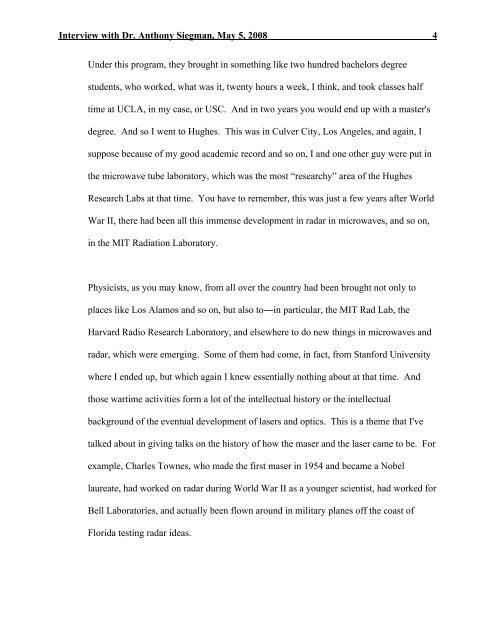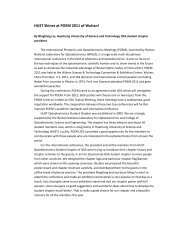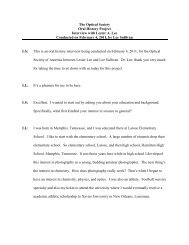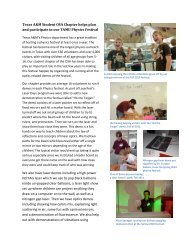The Optical Society Oral History Project Interview with ... - OSA
The Optical Society Oral History Project Interview with ... - OSA
The Optical Society Oral History Project Interview with ... - OSA
Create successful ePaper yourself
Turn your PDF publications into a flip-book with our unique Google optimized e-Paper software.
<strong>Interview</strong> <strong>with</strong> Dr. Anthony Siegman, May 5, 2008 4<br />
Under this program, they brought in something like two hundred bachelors degree<br />
students, who worked, what was it, twenty hours a week, I think, and took classes half<br />
time at UCLA, in my case, or USC. And in two years you would end up <strong>with</strong> a master's<br />
degree. And so I went to Hughes. This was in Culver City, Los Angeles, and again, I<br />
suppose because of my good academic record and so on, I and one other guy were put in<br />
the microwave tube laboratory, which was the most “researchy” area of the Hughes<br />
Research Labs at that time. You have to remember, this was just a few years after World<br />
War II, there had been all this immense development in radar in microwaves, and so on,<br />
in the MIT Radiation Laboratory.<br />
Physicists, as you may know, from all over the country had been brought not only to<br />
places like Los Alamos and so on, but also to―in particular, the MIT Rad Lab, the<br />
Harvard Radio Research Laboratory, and elsewhere to do new things in microwaves and<br />
radar, which were emerging. Some of them had come, in fact, from Stanford University<br />
where I ended up, but which again I knew essentially nothing about at that time. And<br />
those wartime activities form a lot of the intellectual history or the intellectual<br />
background of the eventual development of lasers and optics. This is a theme that I've<br />
talked about in giving talks on the history of how the maser and the laser came to be. For<br />
example, Charles Townes, who made the first maser in 1954 and became a Nobel<br />
laureate, had worked on radar during World War II as a younger scientist, had worked for<br />
Bell Laboratories, and actually been flown around in military planes off the coast of<br />
Florida testing radar ideas.







